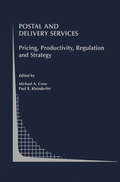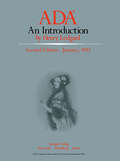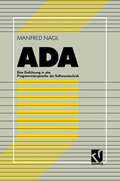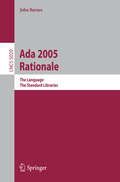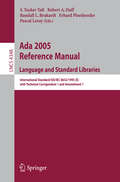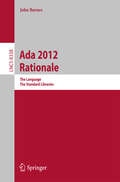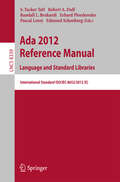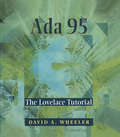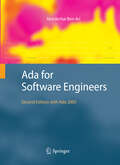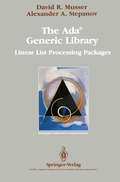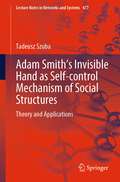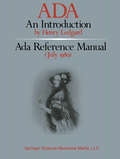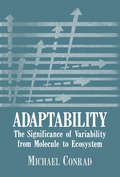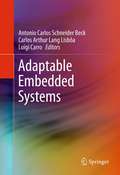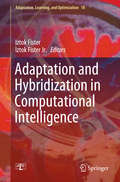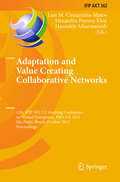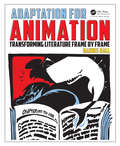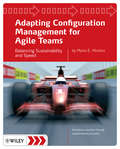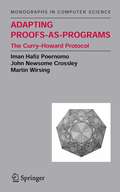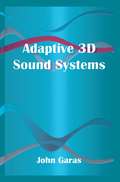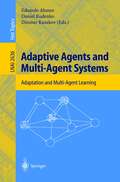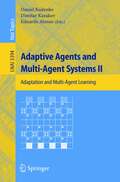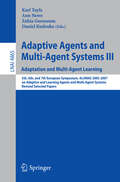- Table View
- List View
Ad Hoc Wireless Networking (Network Theory and Applications #14)
by Xiuzhen Xiuzhen Cheng Xiao Xiao Huang Ding-Zhu Ding-Zhu DuWireless networking enables two or more computers to communicate using standard network protocols without network cables. Since their emergence in the 1970s, wireless networks have become increasingly pop ular in the computing industry. In the past decade, wireless networks have enabled true mobility. There are currently two versions of mobile wireless networks. An infrastructure network contains a wired backbone with the last hop being wireless. The cellular phone system is an exam ple of an infrastructure network. A multihop ad hoc wireless network has no infrastructure and is thus entirely wireless. A wireless sensor network is an example of a multihop ad hoc wireless network. Ad hoc wireless networking is a technique to support robust and ef ficient operation in mobile wireless networks by incorporating routing functionality into mobile hosts. This technique will be used to realize the dream of "anywhere and anytime computing", which is termed mo bile computing. Mobile computing is a new paradigm of computing in which users carrying portable devices have access to shared infrastruc ture in any location at any time. Mobile computing is a very challenging topic for scientists in computer science and electrical engineering. The representative system for ad hoc wireless networking is called MANET, an acronym for "Mobile Ad hoc NETworks". MANET is an autonomous system consisting of mobile hosts connected by wireless links which can be quickly deployed.
ADA®: An Introduction
by Henry LedgardIf Charles Babbage is to be regarded as the father of modern day computer technology, then surely the Countess Augusta Ada Lovelace, after whom this new language is named, must be remembered as its midwife. It was she, the daughter of England's poet Lord Byron, who translated the work of the Italian mathematician L.F. Menabrea, attaching her own scientific commentaries on the dissimilarities between the difference engine and the analytical engine. It was Lady Lovelace, the great lady of computers, who delivered the notes and loosely organized writings of Babbage, with her own invaluable amendments, to a world not quite ready to receive them. The Ada language effort has employed hundreds, if not thousands, of minds and a healthy sum of money since its conception. Ada was fostered by the High Order Language Working Group (HOLWG), chartered by the U.S. Department of Defense in January of 1975 with the overall objective of developing a systematic approach to improved use of software by the military. One would think the Pentagon an unlikely foster parent for a new computer language. Regardless of its lineage, the question that begs asking is, of course - Why? The answer is by no means a simple one, but some brief background may help to clarify the matter. At present, the Department of Defense is the largest software consumer on earth, employing roughly 400 different computer languages and dialects. The situation, some have commented, is at best untidy.
Ada 2005 Rationale: The Language, The Standard Libraries (Lecture Notes in Computer Science #5020)
by John BarnesAda 2005 is the latest version of the International Standard for the programming language Ada. Formally, it is an Amendment of ISO/IEC 8652:1995 (E) rather than a completely new standard. The primary goals for the new version were to enhance its capabilities particularly in those areas where its reliability and predictability are of great value. Accordingly, a number of intriguing and attractive ideas have been included and implemented in a coherent manner as appropriate to the level of perfection necessary for the diligent maintenance of a language standard. The Ada 2005 Rationale describes not only the changes from Ada 95 but also the reason for the changes. It starts with an introduction providing a general overview and this is followed by seven chapters focusing on OOP; access types; structure and visibility; tasking and real time; exceptions, generics, etc.; the predefined library; and containers. The book concludes with an epilogue largely concerned with compatibility issues.
Ada 2005 Reference Manual. Language and Standard Libraries: International Standard ISO/IEC 8652/1995(E) with Technical Corrigendum 1 and Amendment 1 (Lecture Notes in Computer Science #4348)
by S. Tucker Taft Robert A. Duff Randall L. Brukardt Erhard Ploedereder Pascal LeroyThe Ada 2005 Reference Manual combines the International Standard ISO/IEC 8652/1995(E) for the programming language Ada with the corrections of the Technical Corrigendum 1 approved by ISO in February 2001 and with the Amendment 1 expected to be approved by ISO in late 2006 or early 2007. Both the Technical Corrigendum 1 and the Amendment 1 list only the changes made to the International Standard.
Ada 2012 Rationale: The Language -- The Standard Libraries (Lecture Notes in Computer Science #8338)
by John BarnesAda 2012 is the latest version of the international standard for the programming language Ada. It is designated ISO/IEC 8652:2012 (E) and is a new edition replacing the 2005 version. The primary goals for the new version were to further enhance its capabilities particularly in those areas where its reliability and predictability are of great value. Many important new features have been included such as those defining dynamic contracts and for handling multiprocessors and are integrated within the existing language framework in an elegant and coherent manner. The Ada 2012 Rationale describes not only the changes from Ada 2005 but also the reason for the changes. It starts with an introduction providing a general overview and this is followed by seven chapters focusing on contracts and aspects; extended expressions; structure and visibility; tasking and real time; iterators and pools; predefined library and containers. The book concludes with an epilogue largely concerned with compatibility issues.
Ada 2012 Reference Manual. Language and Standard Libraries: International Standard ISO/IEC 8652/2012 (E) (Lecture Notes in Computer Science #8339)
by S. Tucker Taft Robert A. Duff Randall L. Brukardt Erhard Ploedereder Pascal Leroy Edmond SchonbergThe Ada 2012 Reference Manual is an enhanced version of the text of International Standard ISO/IEC 8652/2012(E) for the programming language Ada. The Ada 2012 Reference Manual combines all of the previous corrections of Technical Corrigendum 1 and Amendment 1 with changes and additions that improve the capabilities of the language and the reliability of programs written in the language. The Ada 2012 Reference Manual will replace the former versions as an indispensable working companion for anybody using Ada professionally or learning and studying the language systematically.
Ada 95: The Lovelace Tutorial
by David A. WheelerLovelace provides an introduction to Ada 95, one of the most widely used programming languages in the world. Although the reader is assumed to have a basic understanding of programming, no prior exposure to Ada is assumed and all the basics of the language are covered. The book comprises eighteen chapters each of which is composed of short sections designed to cover a small number of key concept and to provide a test question to check the reader's understanding of the concepts covered. Each chapter then concludes with a small quiz to help ensure that the reader has grasped the principles covered in the chapter. One of Ada 95's new features, its object-oriented facilities, is covered in depth, and all of the essential features of Ada programming are covered thoroughly. In Ada 95 significant enhancements were also added to Ada's ability to interface with other programming languages (such as C, Fortran, and Cobol) and these are covered in one chapter. As a result both students and professional programmers learning Ada for the first time will welcome this new text.
Ada for Software Engineers
by Mordechai Ben-AriAda is the programming language of choice for high integrity software systems and is used extensively in industries such as transportation and aerospace. Special features of the book include: Object-oriented programming, concurrency, and embedded and real-time systems are emphasized. Ada for Software Engineers explains the language concepts and the terminology of the standards document, the Ada Reference Manual (ARM). Extracts from the ARM are used throughtout and there are extensive cross references to the ARM. A comprehensive glossary and technical quizzes assist the reader in developing the ability to use the ARM as a practical reference. Comparisons with familiar languages like C and Java are given to facilitate the transition to Ada. The features of Ada 2005 are used routinely, but they are carefully identified, so that programmers using Ada 95 will also find the textbook useful. The companion website contains the full source code of nearly 100 case studies and 100 technical quizzes.
The Ada® Generic Library: Linear List Processing Packages (Springer Compass International)
by David R. Musser Alexander A. StepanovThe Ada Generic Library provides an extensive well-documented library of generic packages whose use can substantially increase software productivity and reliability. The construction of the library follows a new approach whose principles include the following: - Extensive use of generic algorithms, such as generic sort and merge. - Building up functionality in layers. - Obtaining high efficiency in spite of the layering through the use of Ada's inline compiler directive. This volume contains eight Ada packages, with over 170 subprograms for various linear data structures based on linked lists. Professional Ada programmers will find The Ada Generic Library an invaluable tool in building application programs or in further construction of generic libraries. For these users the source code can be obtained on diskettes. The volume will also be useful to those interested in programming methodology, software reusability, and software engineering.
Adam Smith’s Invisible Hand as Self-control Mechanism of Social Structures: Theory and Applications (Lecture Notes in Networks and Systems #477)
by Tadeusz SzubaThis book shows how such a computational process functions, how great is its power and versatility, since it is possible to show how discoveries are made. In 1759, A. Smith realized that there must exist an additional powerful control mechanism behind Great Britain’s authority and government, explaining the extraordinary successes of Great Britain. He called this the Invisible Hand. Despite having used this term only 3 times, the idea evokes extreme scientific and political emotions to this day. If we apply a molecular model of computation, such as in in Adleman’s DNA computer, a computational model for the Invisible Hand can be built to show how it affects a society. It is a spontaneous, unconscious, distributed, noncontinuous computational process on the platform of minds of, e.g., people or ants. Knowing this mechanism, a future self-steering and self-optimization system for AI robot teams can be proposed, e.g., for construction sites and rescue operations.
ADA An Introduction: Ada Reference Manual (July 1980)
by H. LedgardIf Charles Babbage is to be regarded as the father of modern day computer technology, then surely the Countess Augusta Ada Lovelace, after whom this new language is named, must be remembered as its midwife. It was she, the daughter of England's poet Lord Byron, who translated the work of the Italian mathematician L.F. Menabrea, attaching her own scientific commentaries on the dissimilarities between the difference engine and .the analytical engine. It was Lady Lovelace, the great lady of computers, who delivered the notes and loosely organized writings of Babbage, with her own invaluable amendments, to a world not quite ready to receive them. The Ada language effort has employed hundreds, if not thousands, of minds and a healthy sum of money since its conception. Ada was fostered by the High Order Language Working Group (HOLWG), chartered by the U.S. Department of Defense in January of 1975 with the overall objective of developing a systematic approach to improved use of software by the military. One would think the Pentagon an unlikely foster parent for a new computer language. Regardless of its lineage, the question that begs asking is, of course-Why? The answer is by no means a simple one, but some brief background may help to clarify the matter. At present, the Department of Defense is the largest software consumer on earth, employing roughly 400 different computer languages and dialects. The situation, some have commented, is at best untidy.
Adaptable Embedded Systems
by Antonio Carlos Schneider Beck, Carlos Arthur Lang Lisbôa and Luigi CarroAs embedded systems become more complex, designers face a number of challenges at different levels: they need to boost performance, while keeping energy consumption as low as possible, they need to reuse existent software code, and at the same time they need to take advantage of the extra logic available in the chip, represented by multiple processors working together. This book describes several strategies to achieve such different and interrelated goals, by the use of adaptability. Coverage includes reconfigurable systems, dynamic optimization techniques such as binary translation and trace reuse, new memory architectures including homogeneous and heterogeneous multiprocessor systems, communication issues and NOCs, fault tolerance against fabrication defects and soft errors, and finally, how one can combine several of these techniques together to achieve higher levels of performance and adaptability. The discussion also includes how to employ specialized software to improve this new adaptive system, and how this new kind of software must be designed and programmed.
Adaptation and Hybridization in Computational Intelligence (Adaptation, Learning, and Optimization #18)
by Iztok FisterThis carefully edited book takes a walk through recent advances in adaptation and hybridization in the Computational Intelligence (CI) domain. It consists of ten chapters that are divided into three parts. The first part illustrates background information and provides some theoretical foundation tackling the CI domain, the second part deals with the adaptation in CI algorithms, while the third part focuses on the hybridization in CI.This book can serve as an ideal reference for researchers and students of computer science, electrical and civil engineering, economy, and natural sciences that are confronted with solving the optimization, modeling and simulation problems. It covers the recent advances in CI that encompass Nature-inspired algorithms, like Artificial Neural networks, Evolutionary Algorithms and Swarm Intelligence –based algorithms.
Adaptation and Value Creating Collaborative Networks: 12th IFIP WG 5.5 Working Conference on Virtual Enterprises, PRO-VE 2011, Sao Paulo, Brazil, October 17-19, 2011, Proceedings (IFIP Advances in Information and Communication Technology #362)
by Luis M. Camarinha-Matos Alexandra Pereira-Klen Hamideh AfsarmaneshThis book constitutes the refereed proceedings of the 12th IFIP WG 5.5 Working Conference on Virtual Enterprises, PRO-VE 2011, held in Sao Paulo, Brazil, in October 2011. The 61 revised papers presented were carefully selected from numerous submissions. They provide a comprehensive overview of recent advances in various collaborative network (CN) domains and their applications with a particular focus on adaptation of the networks and their value creation, specifically emphasizing topics related to evolution from social networking to collaborative networks; social capital; value chains; co-creation of complex products; performance management; behavioral aspects in collaborative networks; collaborative networks planning and modeling; benefit analysis and sustainability issues, as well as including important technical and scientific challenges in applying CNs to areas such as advanced logistics networks, business process modeling, service orientation, and other emerging application domains such as ageing, tourism, crisis, and emergency scenarios.
Adaptation for Animation: Transforming Literature Frame by Frame
by Hannes RallTalented animation artists often neglect successful storytelling in favor of strong visuals, but now you can have both with this complete guide to adaptation for animation. Veteran independent filmmaker Hannes Rall teaches you how to draw and adapt inspiration from copyright-free materials like fairy tales, myths, and classic literature, making it easier than ever to create your own compelling narrative. Particular focus is given to making the adequate narrative and visual choices when transferring a text from page to screen: How to create a successful adaptation. With sections on subjects like transcultural adaptations, visual poetry and production design, this book is just the right mix of practical advice, lavish illustrations, and industry case studies to give you everything you need to start adapting your story today. Key features: Learn to apply concepts of adapting classic and modern literature for animation in different techniques Exclusive interviews with animation legends Giannalberto Bendazzi, John Canemaker, Ishu Patel and Georges Schwizgebel Lavishly illustrated with 325 color images (mostly never published before) that give thrilling insights into the visual development of award-winning animated adaptations
Adaptation for Animation: Transforming Literature Frame by Frame
by Hannes RallTalented animation artists often neglect successful storytelling in favor of strong visuals, but now you can have both with this complete guide to adaptation for animation. Veteran independent filmmaker Hannes Rall teaches you how to draw and adapt inspiration from copyright-free materials like fairy tales, myths, and classic literature, making it easier than ever to create your own compelling narrative. Particular focus is given to making the adequate narrative and visual choices when transferring a text from page to screen: How to create a successful adaptation. With sections on subjects like transcultural adaptations, visual poetry and production design, this book is just the right mix of practical advice, lavish illustrations, and industry case studies to give you everything you need to start adapting your story today. Key features: Learn to apply concepts of adapting classic and modern literature for animation in different techniques Exclusive interviews with animation legends Giannalberto Bendazzi, John Canemaker, Ishu Patel and Georges Schwizgebel Lavishly illustrated with 325 color images (mostly never published before) that give thrilling insights into the visual development of award-winning animated adaptations
Adapting Configuration Management for Agile Teams: Balancing Sustainability and Speed
by Mario E. MoreiraAdapting Configuration Management for Agile Teams provides very tangible approaches on how Configuration Management with its practices and infrastructure can be adapted and managed in order to directly benefit agile teams. Written by Mario E. Moreira, author of Software Configuration Management Implementation Roadmap, columnist for CM Crossroads online community and writer for the Agile Journal, this unique book provides concrete guidance on tailoring CM for Agile projects without sacrificing the principles of Configuration Management.
Adapting Configuration Management for Agile Teams: Balancing Sustainability and Speed
by Mario E. MoreiraAdapting Configuration Management for Agile Teams provides very tangible approaches on how Configuration Management with its practices and infrastructure can be adapted and managed in order to directly benefit agile teams. Written by Mario E. Moreira, author of Software Configuration Management Implementation Roadmap, columnist for CM Crossroads online community and writer for the Agile Journal, this unique book provides concrete guidance on tailoring CM for Agile projects without sacrificing the principles of Configuration Management.
Adapting Proofs-as-Programs: The Curry--Howard Protocol (Monographs in Computer Science)
by Iman Poernomo John N. Crossley Martin WirsingThis monograph details several important advances in the direction of a practical proofs-as-programs paradigm, which constitutes a set of approaches to developing programs from proofs in constructive logic with applications to industrial-scale, complex software engineering problems. One of the books central themes is a general, abstract framework for developing new systems of programs synthesis by adapting proofs-as-programs to new contexts.
Adaptive 3D Sound Systems (The Springer International Series in Engineering and Computer Science #566)
by John GarasAdaptive 3D Sound Systems focuses on creating multiple virtual sound sources in 3D reverberant spaces using adaptive filters. Adaptive algorithms are introduced and explained, including the multiple-error filtered-x algorithm and the adjoint LMS algorithm. The book covers the physical, psychoacoustical, and signal processing aspects of adaptive and non-adaptive 3D sound systems. Included is an introduction to spatial hearing, sound localization and reverberation, frequency selectivity of the human auditory system, the state of the art in HRTF-based 3D sound systems, binaural synthesis, and loudspeaker displays. The adaptive approach to HRTF-based 3D sound systems is examined in detail for the general case of creating multiple virtual sound sources at the ears of multiple listeners in a reverberant 3D space. The derived solution can be applied to other applications, such as cross-talk cancellation, loudspeakers and room equalization, concert hall simulation, and active sound control. Several solutions for the problem of moving listeners are introduced. Strategies for enlarging the zones of equalization around the listeners' ears, correct loudspeakers positioning, and using multiresolution filters are proposed. Fast multiresolution spectral analysis using non-uniform sampling is developed for implementation of multiresolution filters. The well-focused topics, along with implementation details for adaptive algorithms, make Adaptive 3D Sound Systems suitable for multimedia applications programmers, advanced level students, and researchers in audio and signal processing.
Adaptive Agents and Multi-Agent Systems: Adaptation and Multi-Agent Learning (Lecture Notes in Computer Science #2636)
by Eduardo Alonso Daniel Kudenko Dimitar KazakovAdaptive Agents and Multi-Agent Systems is an emerging and exciting interdisciplinary area of research and development involving artificial intelligence, computer science, software engineering, and developmental biology, as well as cognitive and social science. This book surveys the state of the art in this emerging field by drawing together thoroughly selected reviewed papers from two related workshops; as well as papers by leading researchers specifically solicited for this book. The articles are organized into topical sections on - learning, cooperation, and communication - emergence and evolution in multi-agent systems - theoretical foundations of adaptive agents
Adaptive Agents and Multi-Agent Systems II: Adaptation and Multi-Agent Learning (Lecture Notes in Computer Science #3394)
by Daniel Kudenko Dimitar Kazakov Eduardo AlonsoAdaptive agents and multi-agent systems is an emerging and exciting interdisciplinary area of research and development involving artificial intelligence, software engineering, and developmental biology, as well as cognitive and social science. This book presents 17 revised and carefully reviewed papers taken from two workshops on the topic as well as 2 invited papers by leading researchers in the area. The papers deal with various aspects of machine learning, adaptation, and evolution in the context of agent systems and autonomous agents.
Adaptive Agents and Multi-Agent Systems III. Adaptation and Multi-Agent Learning: Adaptation and Multi-Agent Learning, 5th, 6th, and 7th European Symposium, ALAMAS 2005-2007 on Adaptive and Learning Agents and Multi-Agent Systems, Revised Selected Papers (Lecture Notes in Computer Science #4865)
by Karl Tuyls Ann Nowe Zahia Guessoum Daniel KudenkoThis book contains selected and revised papers of the European Symposium on Adaptive and Learning Agents and Multi-Agent Systems (ALAMAS), editions 2005, 2006 and 2007, held in Paris, Brussels and Maastricht. The goal of the ALAMAS symposia, and this associated book, is to increase awareness and interest in adaptation and learning for single agents and mul- agent systems, and encourage collaboration between machine learning experts, softwareengineeringexperts,mathematicians,biologistsandphysicists,andgive a representative overviewof current state of a?airs in this area. It is an inclusive forum where researchers can present recent work and discuss their newest ideas for a ?rst time with their peers. Thesymposiaseriesfocusesonallaspectsofadaptiveandlearningagentsand multi-agent systems, with a particular emphasis on how to modify established learning techniques and/or create new learning paradigms to address the many challenges presented by complex real-world problems. These symposia were a great success and provided a forum for the pres- tation of new ideas and results bearing on the conception of adaptation and learning for single agents and multi-agent systems. Over these three editions we received 51 submissions, of which 17 were carefully selected, including one invited paper of this year’s invited speaker Simon Parsons. This is a very c- petitive acceptance rate of approximately 31%, which, together with two review cycles, has led to a high-quality LNAI volume. We hope that our readers will be inspired by the papers included in this volume.
